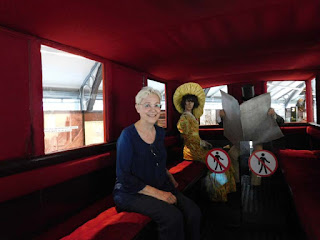Last year, during my visit to the London Transport Museum, I encountered a form of public transportation I hadn’t paid much attention to previously.
The omnibus was first introduced in Paris, and it was a Parisian coach-builder, George Shillibeer, who brought the concept to London.
“The route which Shillibeer chose for his first omnibus was from the Yorkshire Stingo at Paddington, along the New Road to the Bank. The New Road was the name by which Marylebone, Euston and Pentonville Roads were then known.Though his omnibus was a success, Shillibeer contended with fierce and often unscrupulous competition and the NIMBY inhabitants of Paddington Green—although “the threatened doom of Paddington Green did not deter the sentimental poke-bonneted young ladies, who resided in the charming suburb, from spending a considerable amount of their time in watching the omnibuses start. In the middle of the day many of them were in the habit of taking a ride to King's Cross and back, for the sole purpose of improving their French by conversing with the conductors.”
... On the morning of July 4, 1829, Shillibeer's two new omnibuses began to run. A large crowd assembled to witness the start, and general admiration was expressed at the smart appearance of the vehicles, which were built to carry twenty-two passengers, all inside, and were drawn by three beautiful bays, harnessed abreast. The word "Omnibus" was painted in large letters on both sides of the vehicles. The fare from the Yorkshire Stingo to the Bank was one shilling; half way, sixpence. Newspapers and magazines were provided free of charge. The conductors, too, came in for considerable notice, for it had become known that they were both the sons of British naval officers—friends of Shillibeer. These amateur conductors had resided for some years in Paris, and were, therefore, well acquainted with the duties of the position which they assumed. The idea of being the first omnibus conductors in England pleased them greatly, and prompted them to work their hardest to make Shillibeer's venture a success. They were attired in smart blue-cloth uniforms, cut like a midshipman's; they spoke French fluently, and their politeness to passengers was a pleasing contrast to the rudeness of the short-stage-coach* guards—a most ill-mannered class of men. Each omnibus made twelve journeys a day, and was generally full.”
— Henry Charles Moore, Omnibuses and Cabs 1902
Anecdotes like this abound, including tales of theft by the paid conductors who soon replaced the gentlemen. Since space doesn’t permit me to quote at length, I recommend you read at least Chapter II of the first part for yourself.

*Short-stage coaches, which had been in existence from the mid-18th century, ran—slowly, expensively, and unpunctually—from the suburbs to the City and the West End.
Images: Photos of Loretta in omnibus at London Transport Museum, View of Exterior London Transport Museum Omnibus, and Announcement Marking the End of the Omnibus Era taken at London Transport Museum, copyright © 2018 Walter M. Henritze III.
Clicking on the image will enlarge it. Clicking on a caption link will take you to the source, where you can learn more and enlarge images as needed.


 One of us --
One of us -- 



1 comments:
To some Londoners the crowning insult was when Shillibeer introduced his "Funeral Omnibus" - it was intended to serve the needs of small funerals by eliminating the need for extra carriages, and contained a compartment for the casket which could be collapsed into the body of the vehicle when not needed. It was widely lampooned.
Post a Comment